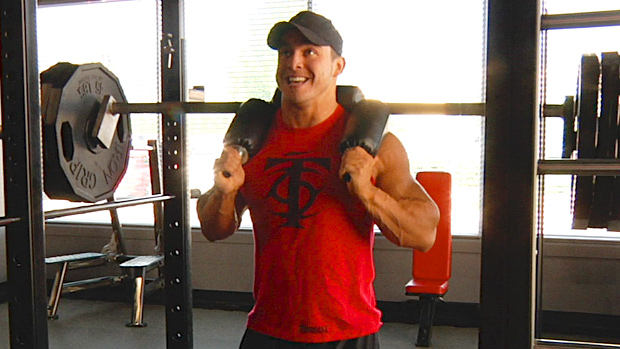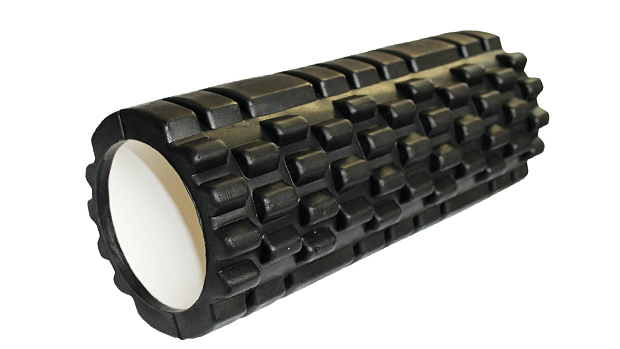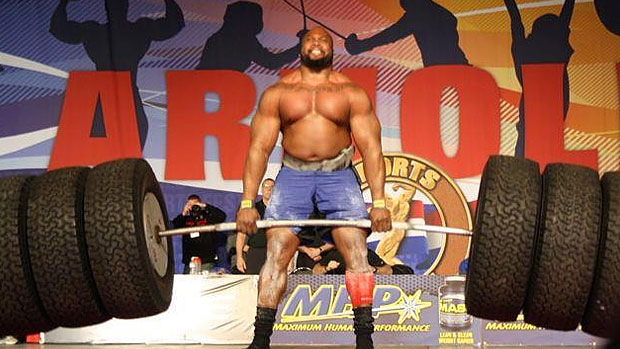You'll know you're dealing with impingement if you've got a pinching pain on the front of your shoulder after doing the bench press, overhead press, or any variation of the two.
Ready to get your shoulders feeling good again? Here's your roadmap to recovery.
Instead of just looking at the shoulder joint, we need to look at the whole thoracic spine, including how the shoulder blades move.
If your thoracic spine (upper back) doesn't have the ability to extend well, the ball of your humerus (upper arm bone) won't have enough space to freely move around in the socket of the scapula. This lack of space causes your scapula's acromion process to pinch down on the tendons of the rotator cuff/long head of the bicep tendon, which causes pain and inflammation in the front of the shoulder.
Try this three-step approach of soft tissue work, mobilization drills, and strengthening your mid/upper back to address this problem.
For soft tissue work, your goal should be to relax or "turn down" certain muscles that are overactive or restrictive. Apply deep, slow, and steady pressure.
Don't put so much pressure on your tissues that you contract your muscles and wince in pain. You shouldn't need a leather strap to bite on and a shot of whisky.
If this is the case, you're either applying too much pressure, going too fast, or the material you've chosen is too hard. A muscle that's experiencing pain during soft tissue work will stay contracted to protect itself.
Here's what to do:
T-Spine Peanut Mobilization
Although you can use a foam roller to mobilize the T-spine, my favorite way of doing this is with a "peanut" tool, which allows you the freedom to extend the T-spine at each vertebral joint. This helps you find where your greatest restriction is and allows you to address it.
Note: In the video, I'm using a Mobo Max tool, but you can also make your own peanut by taping together two tennis balls or lacrosse balls.
When rolling your thoracic spine, start with the peanut in the middle of your back between your shoulder blades. Cross your arms to get your shoulder blades out of the way.
When you feel a restriction, pause on it for a few seconds and apply deep pressure. After applying pressure, extend your T-spine over the peanut where you felt the restriction. Keep your core engaged so that you're only extending your upper back.
A common error is over-arching your lower back which negates the movement of the upper back.
Foam Roll the Lats

Go slow and be methodical. Feel for any restrictions and pause on them if you feel an area is overly tender.
As a bonus, you can reach your palm towards the ceiling once you "tack down" a certain area. Think of this as a form of Active Release Technique (ART). Roll each side for about one minute.
Foam Roll the Pecs

Start on the outside of your chest with your palm facing the ground. Go slow and pause on any areas that seem tender or restricted. If you find an area that's particularly restricted, reach your hand away from your body to increase the stretch's intensity.
Now it's time to get your upper back and shoulder blades moving freely again. Begin with simple, restorative drills before moving on to more complex and dynamic ones. These will get your upper back moving properly again:
Cat-Cow
This drill will restore movement to your entire back by opening up the joints in your spine and stretching the surrounding musculature.
The goal is to achieve gentle and rhythmic motion of your spine. Don't try to overly exaggerate each stretch. Instead, allow for smooth movement to occur and make mental notes of where you feel restrictions.
Begin by inhaling as you retract your shoulder blades and lift your head/chest as you move into cow position. You should have a slight arch in your lower back and feel a stretch in your abdomen.
Next, exhale as you round your upper back and tuck your chin to your chest. Think of pulling your belly button towards your spine. You should feel a stretch in your upper back as your shoulder blades pull apart.
Pause for a couple of seconds at the top and bottom of each stretch. Hold your breath to increase the effectiveness.
Foam Roller Overhead Reach
This is great for gaining the ability to extend your upper back. The foam roller provides a narrow enough surface so that your shoulder blades can freely and upwardly rotate as you reach overhead.
Keep your head, mid-back, and tailbone on the roller. Don't compensate for this movement by arching your low back as you reach overhead.
You can use a dowel rod, but if you have an acute case of impingement, try using a neutral-arm position and a circular mini band to make this drill feel better. The neutral-arm position will put your shoulder in a safer position to reach overhead.
Pressing out against the band will turn on your upper back/shoulder musculature, which will help stabilize your shoulder as you move your arms overhead.
Scap Push-Up
This trains active protraction and passive retraction of the shoulder blades. It strengthens your serratus anterior, which is the muscle that pulls the scapula forward and around the ribcage.
Keep your elbows straight and focus on only moving your upper back. Don't allow your hips to rise or sag.
Scap Pull-Up
This trains active downward rotation/depression and passive upward rotation/elevation of the scapula. It also serves as a great decompression stretch for your shoulder complex.
Keep your elbows straight and focus on sliding your shoulder blades down your back as you engage your lats on the pull. Use a neutral grip if an overhand grip is painful to your shoulder.
Scrape-the-Rack Press
This allows you to enhance T-spine mobility while offering more stability for your shoulder than the standard overhead press. Pushing the bar against the rack as you drive it overhead provides more stability for the shoulder and allows you to keep constant tension on your musculature, which can help ease pain.
Set the pins so the bar is approximately neck height. As you push the bar up, focus on pulling your upper body through as you drive the bar overhead.
Once your shoulders are moving freely again, you'll need to strengthen your mid and upper back. This area must be strong for stabilization of the shoulder. If your mid and upper back aren't working to stabilize your shoulder properly, it won't stay in proper alignment during pressing, which will continue causing pain.
Here are a few exercises that are simple and require little-to-no setup time. Pause for 10 seconds on your last rep of each to "lock-in" your shoulder stability.
Horizontal Band Pull-Apart
Keep your elbows straight and focus on squeezing your shoulder blades together on each rep. Doing your reps with the palms both over and under will allow you to target your back musculature from different angles. Pause for 10 seconds on your last rep.
Behind the Back W Press
Begin by squeezing your shoulder blades and externally rotating your shoulders so that your elbows point towards your ribs. Next, reach your hands away from your body as you stretch the band.
Don't allow your shoulder to round forward and keep your elbows from flaring out as you do this. Then tuck your elbows back in towards your sides as you return to the starting position. Remember to pause for 10 seconds on the last rep.
45-Degree Inverted Row
When using the inverted row for shoulder stability, use suspension straps and a 45-degree body angle. The straps allow your shoulders to freely rotate and don't lock you into a fixed position like a barbell would. Using a 45-degree body angle will create a line of pull so that your mid-back does the work.
Start with your palms facing down and arms fully extended. Rotate your palms so that they face up as you pull yourself to the handles of the suspension straps. Rotating the palms while doing the movement will create better back engagement and ensure you keep your shoulders in a tight and packed position.
The lower you can pull your elbows toward your ribcage, the more your mid back will work. Don't allow yourself to shrug up and pull. This will over-activate the upper traps and take away from what you're trying to target.
If you're jammed for time, doing all the drills and exercises can seem daunting. Here's how to get your mobility and activation drills done quickly:
Shoulder Prep Warm-Up
| Exercise | Sets | Reps | |
|---|---|---|---|
| A | T-Spine Peanut Mobilization | 1 minute | |
| B | Lat Foam Roll | 1 minute each side | |
| C | Pec Foam Roll | 1 minute each side | |
| D | Cat-Cow | 1 | 10 |
| E | Foam Roller Overhead Reach | 1 | 10 |
| F | Scap Push-Up | 1 | 10 |
| G | Scap Pull-Up | 1 | 10 |
| H | Scrape-the-Rack | 1 | 10 |
| I | Band Pull-Apart | 1 | 10 each |
| J | Banded W Press | 1 | 10 |
| K | 45-Degree Inverted Row | 1 | 10 |
Total Time to Complete: 7-10 minutes.
T Nation earns from qualifying purchases as an Amazon Associate. Read more about our policy.





